This guide explains how to create a Windows bootable USB drive for the following Windows versions: Windows XP, Windows Vista, Windows 7, Windows 8, Windows 8.1, Windows 10, and Windows 11.
Creating a bootable USB drive will allow you to install Windows from the USB drive directly.
To be able to install Windows from a USB, you need have one of the following:
- the ISO image of the Windows version
- or the original installation disc of the Windows version
If you don’t have either, you can instead download an EasyRE ISO image that can be made into a bootable USB or CD to restore your PC.
Contents
Prerequisites
Before you start creating a bootable USB flash drive to install Windows (XP, Vista, 7, 8, 8.1, 10), you need to make sure that:
- The USB drive is empty and properly formatted
- The USB drive is bootable
- Your BIOS/UEFI is properly configured to boot from the USB flash drive first
- You have the ISO image of Windows XP, Vista, 7, 8 or 8.1. If you have the original Windows installation disc, you can use that instead of the ISO image.
- Software needed to write the ISO image to the USB drive or alternatives, such as Easy USB Creator 2.0 by NeoSmart or the Windows 7 USB/DVD Download Tool by Microsoft.
USB Drive
The USB drive you want to make bootable should have at least 4 GB in available size.
BIOS/UEFI configuration
To make sure that your BIOS/UEFI is configured to boot from a USB drive, follow our Boot from USB drive guide. You need to make sure that:
If a Boot Device menu doesn’t appear on your screen where the USB drive is plugged-in, check the BIOS/UEFI settings. A Boot Device menu can look like this, depending on your computer model and Windows version:
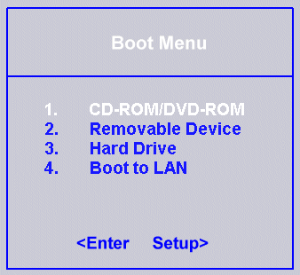
If you are using a new computer with UEFI/EFI, make sure that the Boot Legacy option is enabled:
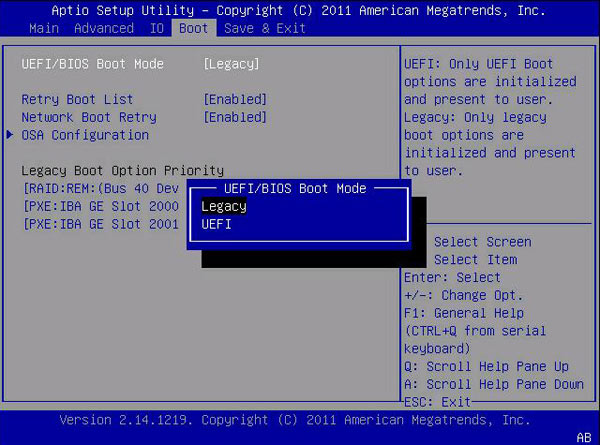
If you’re using a computer with Fast Boot option, make sure that Fast Boot is disabled.
If your BIOS menu doesn’t list a USB item in the BIOS settings, it may mean that it can’t boot from a USB drive. You can try with the USB drive plugged-in and then boot into BIOS directly.
If the item doesn’t appear, you need to use the original Windows installation CD or DVD to install Windows or access the repair tools.
If you need to use the repair tools of an original Windows installation CD/DVD, you can also use Easy Recovery Essentials (download link) and run Automated Repair to automatically find and fix boot errors.
Download Easy Recovery Essentials
ISO image
If you don’t have the ISO image to create the bootable USB drive, you can download an official image from Microsoft’s website.
You need to have the product (or license) key.
Create a Windows XP bootable USB
You can create a bootable USB drive with Windows XP by following these instructions.
Using Easy USB Creator 2.0
Easy USB Creator can quickly convert the ISO images into bootable USB drives, with just a single click:
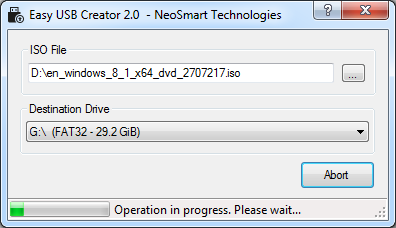
To burn Windows XP to a USB drive using Easy USB Creator 2.0, simply follow these steps:
- Download USB Creator 2.0
- Install Easy USB Creator 2.0
- Browse the Windows XP ISO Image to load at the ISO File field
- Select the destination of your USB Drive at the Destination Drive field
- Start
Easy USB Creator 2.0 supports both USB 2.0 and USB 3.0.
It’s compatible with Windows XP, Windows Vista, Windows 7, Windows 8, Windows 8.1, Windows 10 plus the Windows Server editions (2003, 2008, 2012). You must have .NET Framework 2.0 or higher in order to use Easy USB Creator 2.0
If you have the installation disc (CD)
If you have the original Microsoft Windows XP Professional installation CD, you can use the CD to create a bootable USB using PE Builder.
It’s important to have the following before you start:
- The Windows Server 2003 SP1 archive. If not, download from Microsoft now: Microsoft Windows Server 2003 Service Pack 1 (32 bit)
- The PE Builder software (BartPE). If not, download BartPE
- The original CD of Windows XP Professional, not a Windows XP Home CD.
A Windows XP Home CD will not work.
To create the bootable drive with Windows XP, follow these steps:
- Boot into the system
- Download the PE Builder software from http://www.nu2.nu/pebuilder/
- Install the PE Builder to
C:\. The final path should beC:\PEBuilderto make the next steps easier.
Inside the PEBuilder folder, create a new folder named SRSP1. This folder’s path should be C:\PEBuilder\SRSP1.
- Download the Windows Server 2003 SP1 archive from http://www.microsoft.com/en-us/download/details.aspx?id=1143…
- Rename the archive downloaded from Microsoft to
MS-WS-SP1.exe - Open Command Prompt. You can also open it by typing
cmdin the Run dialog box and pressing Enter afterwards. - Type the
cdcommand to go to the folder where the MS-WS-SP1.exe file exists:cd c:\downloads
Don’t type MS-WS-SP1.exe in the path above. You only need to go to the folder where the file exists.
Replace
c:\downloadswith the letter of the drive and the directory where the MS-WP-SP1.exe file exists. - Type
MS-WS-SP1.exe -xto begin the extraction process, press Enter - Choose to extract the files to the same folder, e.g.
c:\downloads:
PEBuilder: Extract Files
- In Command Prompt, you now need to go to the extract folder at the i386 sub-folder.To do so, type the same
cdcommand, if you’re still at the c:\downloads folder in Command Prompt and you haven’t created a new folder for the extracted files:cd i386
If you created a new folder for the extract files, say Extract, in c:\downloads, update the cd command to go to that folder:
cd c:\downloads\Extract
Then, type
cd i386, press Enter - Once inside the i386 folder via Command Prompt, type:
copy setupldr.bin c:\PEBuilder\SRSP1
Replace
c:\PEBuilder\with the path where the PE Builder software is installed, if this was changed in previous steps. - While still in Command Prompt, expand the ramdisk.sys file with this command:
expand -r ramdisk.sy_ c:\PEBuilder\SRSP1
Replace
c:\PEBuilder\with the path where the PE Builder software is installed, if this was changed in previous steps. - Go to My Computer
- Go to PEBuilder folder
- Go to SRSP1 folder
- Check that you have the 2 files listed there: setupldr.bin and ramdisk.sys

PEBuilder: Check that you have the files copied
- Insert the Windows XP Professional CD in the disk tray
- Launch PE Builder
- Make the following changes before you click Build:
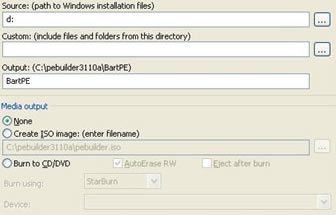
BartPE: Configuration for Windows XP USB
- At the Source field, type the letter of the drive for the Windows XP CD, e.g. e:\
- At the Output field, type BartPE
- Leave the Custom field blank
- Media output should be None
- Click Build
- When the build process is complete, click Close
- Go to Command Prompt and then go to the PEBuilder folder by typing the
cdcommand:cd c:\PEBuilder
- Type this command (make sure the USB flash drive is not removed) and press Enter:
pe2usb -f d:
Replace
d:with the letter of the drive where your USB flash drive is loaded. - Type
YES, when prompted to begin the process. Press Enter after typing YES. - Press any key to exit the pe2usb process, after the process is complete
- Safely remove the USB flash drive from the port
- Remove the Windows XP CD from the disk try
- Reboot the system to check if the USB flash drive is now bootable with Windows XP Professional
If your computer doesn’t boot into the USB drive directly, go to Prerequisites > BIOS/UEFI configuration or read the Boot from USB drive guide to configure your BIOS menu to boot from a USB device first.
Create a Windows Vista bootable USB
Depending if you have the ISO image of Windows Vista or the original DVD, you can use Easy USB Creator 2.0 or the diskpart utility to create the bootable USB.
If you have the ISO image
Using Easy USB Creator 2.0
Easy USB Creator can quickly convert the ISO images into bootable USB drives, with just a single click:

To burn Windows Vista to a USB drive using Easy USB Creator 2.0, simply follow these steps:
- Download USB Creator 2.0
- Install Easy USB Creator 2.0
- Browse the Windows Vista ISO Image to load at the ISO File field
- Select the destination of your USB Drive at the Destination Drive field
- Start
Easy USB Creator 2.0 supports both USB 2.0 and USB 3.0.
It’s compatible with Windows XP, Windows Vista, Windows 7, Windows 8, Windows 8.1, Windows 10 plus the Windows Server editions (2003, 2008, 2012). You must have .NET Framework 2.0 or higher in order to use Easy USB Creator 2.0
Using Windows 7 USB/DVD Download Tool
To create the bootable drive with the Windows 7 USB/DVD Download Tool, follow the steps from Using the Windows 7 USB/DVD Download Tool from Windows 8/8.1.
While the name is “Windows 7”, you can use the tool for Windows Vista systems too.
If you have the installation disc (DVD)
To create a bootable USB with Windows Vista and install the operating system from that USB drive, follow the steps.
You’ll be using the diskpart utility, available in Windows Vista, to make the USB drive bootable. You’ll copy the files from the installation disc (DVD) to the USB drive after the diskpart utility process is finished.
The instructions are:
- Boot your computer
- Open Command Prompt and run it as Administrator.You can go at Start > All Programs Accessories > Command Prompt or type
cmdin the search field.To run Command Prompt as Administrator, right-click on the Command Prompt item and select Run as Administrator. - When Command Prompt opens, type this command and press Enter:
cd c:\windows\system32
Replace
c:\with the letter of the driver where your Windows Vista is installed: C:\, D:\ etc. - Insert the USB flash drive in the USB port
- Type:
diskpart
- Press Enter
- Type:
list disk
- Press Enter
- After you press Enter for the list disk command, Command Prompt will list the drives that are connected to your computer. Find the USB drive and its corresponding number.

Command Prompt: list disk
- Then, type this command:
select disk X
Where
Xis the number of the USB flash drive listed by Command Prompt.The confirmation message should be:
Disk 1 is now the selected disk.
- Press Enter
- Type
cleanand press Enter - Type
create partition primaryand press Enter - Type
select partition 1and press Enter - Type
activeand press Enter - Type this command and press Enter afterwards:
format fs=ntfs
It may take a few minutes to format the entire USB flash drive, depending on its size. However, you can use the quick parameter to format the drive more quickly:
format fs=ntfs quick
- Type
assign, press Enter - Type
exit, press Enter - Insert the Windows Vista DVD in the optical drive
- Go to My Computer
- Note the letter of the drive where the Windows Vista DVD is loaded, e.g. D:\, E:\
- Go back to Command Prompt and check if the USB flash drive has been formatted
- When the format process is complete, type this command and press Enter:
d: cd boot
Replace
D:with the letter of the drive where the Windows Vista DVD is loaded - Then type
cd bootand press Enter - Type this command and press Enter:
bootsect.exe /nt60 f:
Where
f:is the letter of the drive where your USB flash drive is loaded - Copy all files from the Windows Vista DVD on the USB flash drive.To open the contents of the DVD (and not load the splash screen of the Windows Vista DVD), right-click on the drive and click Open.
If you followed the above instructions correctly, the USB flash drive should now be bootable with Windows Vista.
You can check this by plugging the USB and rebooting the system. To make sure that your computer boots from a USB drive first, and not from the hard disk, go to BIOS/UEFI configuration.
Create a Windows 7 bootable USB
You can create the bootable USB drive with Windows 7, if:
- you have the ISO image of Windows 7
- or you have the original installation DVD of Windows 7
If you have the ISO image
Using Easy USB Creator 2.0
Easy USB Creator can quickly convert the ISO images into bootable USB drives, with just a single click:

To burn Windows 7 to a USB drive using Easy USB Creator 2.0, simply follow these steps:
- Download USB Creator 2.0
- Install Easy USB Creator 2.0
- Browse the Windows 7 ISO Image to load at the ISO File field
- Select the destination of your USB Drive at the Destination Drive field
- Start
Easy USB Creator 2.0 supports both USB 2.0 and USB 3.0.
It’s compatible with Windows XP, Windows Vista, Windows 7, Windows 8, Windows 8.1, Windows 10 plus the Windows Server editions (2003, 2008, 2012). You must have .NET Framework 2.0 or higher in order to use Easy USB Creator 2.0
Using Windows 7 USB/DVD Download Tool
The Windows 7 USB/DVD Download Tool is available to download and you can use it to create a bootable ISO image from the ISO image you purchased and downloaded from Microsoft.
Before you continue with these instructions, please make sure that:
- You have the Windows 7 USB/DVD Download Tool downloaded. If not, download Windows 7 USB/DVD Download Tool now.
- You have the Windows 7 ISO Image ready
The instructions are:
- Download Windows 7 USB/DVD Download Tool from http://wudt.codeplex.com/ and launch it
- At the Source File field, click Browse and find the Windows 7 ISO image on your computer and load it
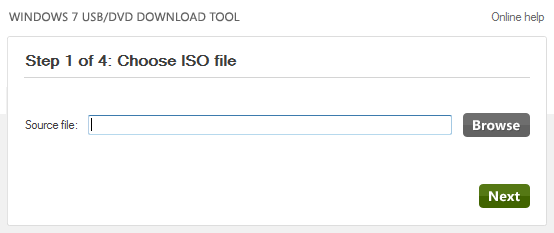
Windows 7 USB/DVD Download Tool: Source File
- Click Next
- Select USB Device
- Select the USB flash drive from the drop down menu
- Click Begin copying
- Exit the application, when the process is complete
If you have the installation disc (DVD)
You can use a USB flash drive (see Prerequisites for more information) to install Windows 7 from.
To do so, you need to make the USB flash drive bootable first and then use the original Windows 7 installation disc (DVD) to copy the contents of the DVD to the USB drive.
The diskpart utility, part of Windows 7, will be used.
Follow these steps (similar to Create a Windows Vista bootable USB > If you have an installation disc):
- Start the computer
- Open Command Prompt as Administrator. Go at Start > All Programs Accessories > right-click on the Command Prompt item and select Run as Administrator.
- Enter the password for the Administrator account
- At Command Prompt, type:
cd c:\windows\system32
Replace
c:\with the letter of the driver where your Windows 7 is installed: C:\, D:\ etc. - Press Enter
- Insert the USB drive that you want to make bootable in an available port
- Type
diskpartand press Enter - Type
list diskand press Enter
Command Prompt: list disk
- Find the USB drive and its corresponding number in the list provided by Command Prompt
- Type this command and press Enter:
select disk X
Where
Xis the number of the USB drive listed by Command Prompt above.The confirmation message should be:
Disk 1 is now the selected disk.
- Type
clean, press Enter - Type
create partition primary, press Enter - Type
select partition 1, press Enter - Type
active, press Enter - Type
format fs=ntfsand press Enter.
You can use the quick parameter to format the drive more quickly: format fs=ntfs quick
- Insert the Windows 7 DVD and go to My Computer. Note the letter of the drive where the DVD is loaded, e.g. D:\, E:\
- Type
assign, press Enter - Type
exit, press Enter - After the format process is complete, type this command in Command Prompt and press Enter:
d: cd boot
Where
d:with the letter of the drive where the Windows 7 DVD is loaded. - Type
cd boot, press Enter - Type this command and press Enter:
bootsect.exe /nt60 f:
Where
f:is the letter of the drive where the USB flash drive is loaded - Open the contents of the Windows 7 DVD: right-click on the drive and click Open
- Copy all files from the DVD to the USB
Create a Windows 8 / 8.1 bootable USB
Depending if you have the ISO image of Windows Vista or the original DVD, you can use Easy USB Creator 2.0 to create the USB if you have the ISO image or the diskpart utility to create the bootable USB, if you have the DVD.
If you have the ISO image
Using Easy USB Creator 2.0
Easy USB Creator can quickly convert the ISO images into bootable USB drives, with just a single click:

To burn Windows 8 or 8.1 to a USB drive using Easy USB Creator 2.0, simply follow these steps:
- Download USB Creator 2.0
- Install Easy USB Creator 2.0
- Browse the Windows 8 or Windows 8.1 ISO Image to load at the ISO File field
- Select the destination of your USB Drive at the Destination Drive field
- Start
Easy USB Creator 2.0 supports both USB 2.0 and USB 3.0.
It’s compatible with Windows XP, Windows Vista, Windows 7, Windows 8, Windows 8.1, Windows 10 plus the Windows Server editions (2003, 2008, 2012). You must have .NET Framework 2.0 or higher in order to use Easy USB Creator 2.0
Using Windows 7 USB/DVD Download Tool
The Windows 7 USB/DVD Download Tool is available to download and you can use it to create a bootable ISO image from the ISO image you purchased and downloaded from Microsoft.
While the name is “Windows 7”, you can use this tool on a Windows 8 or 8.1 system too.
Before you continue with these instructions, please make sure that:
- You have the Windows 7 USB/DVD Download Tool downloaded. If not, download the Windows 7 USB/DVD Download Tool now.
- You have the Windows 8 or 8.1 ISO Image ready
The instructions are:
- Launch the Windows 7 USB/DVD Download Tool
- At the Source File field, click Browse and find the Windows 8 or 8.1 ISO image on your computer

Windows 7 USB/DVD Download Tool: Source File
- Click Next
- Insert the USB flash drive in an available port on your computer. Make sure it’s loaded in My Computer.
- At Step 2, select USB Device to write the ISO image to the USB drive. You can click DVD to write the ISO image to a DVD instead.
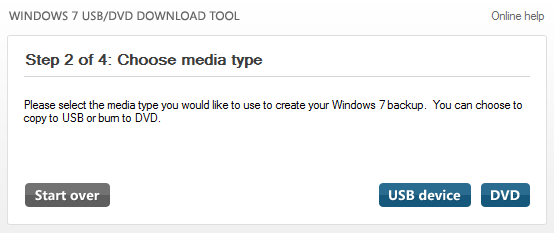
Windows 7 USB/DVD Download Tool: Choose Media Type
- At Step 3, select the USB flash drive from the drop down menu. If the drive isn’t loaded yet, you can click on the Refresh icon next to the drop down menu.
- Click Begin copying
- When done, exit the Windows 7 USB/DVD Download Tool

Windows 7 USB/DVD Download Tool: Done
If you have the installation disc (DVD)
If you have the original installation disc (DVD) of Microsoft Windows 8 or Windows 8.1 you can create a bootable USB drive.
To do so, follow the steps below:
- Boot into Windows 8 or 8.1
- Open Command Prompt as Administrator. To do so, press the
and C key to search for
cmd. From the search results list, right-click on Command Prompt

- Click Run as administrator

- Enter the password, when prompted
- When Command Prompt opens, type this command and press Enter:
diskpart
- Insert the USB flash drive in the port
- Type
list disk, press Enter
Command Prompt: list disk
- Identify the number next of the USB drive in the list provided by the list disk command
- Type
select disk X, press Enter. ReplaceXwith the number of the USB drive listed from above steps.
Command Prompt: select disk
The confirmation message should be:
Disk 1 is now the selected disk.
- Type
clean, press Enter - Type
create partition primary, press Enter - Type
select partition 1, press Enter - Type
active, press Enter - Type
format fs=ntfs, press Enter. To have the USB drive formatted more quickly, add the quick parameter:format fs=ntfs quick - Type
assign, press Enter - Type
exit, press Enter - Copy the contents of the Windows 8 DVD or 8.1 DVD to the USB flash drive
Create a Windows 10 bootable USB
If you have the ISO image
Using Easy USB Creator 2.0
Easy USB Creator can quickly convert the ISO images into bootable USB drives, with just a single click:

To burn Windows 10 to a USB drive using Easy USB Creator 2.0, simply follow these steps:
- Download USB Creator 2.0
- Install Easy USB Creator 2.0
- Browse the Windows 10 ISO Image to load at the ISO File field
- Select the destination of your USB Drive at the Destination Drive field
- Start
Easy USB Creator 2.0 supports both USB 2.0 and USB 3.0.
It’s compatible with Windows XP, Windows Vista, Windows 7, Windows 8, Windows 8.1, Windows 10 plus the Windows Server editions (2003, 2008, 2012). You must have .NET Framework 2.0 or higher in order to use Easy USB Creator 2.0
Using Windows 7 USB/DVD Download Tool
The Windows 7 USB/DVD Download Tool is available to download and you can use it to create a bootable ISO image from the ISO image you purchased and downloaded from Microsoft.
While the name is “Windows 7”, you can use this tool on a Windows 10 system too.
Before you continue with these instructions, please make sure that:
- You have the Windows 7 USB/DVD Download Tool downloaded. If not, download the Windows 7 USB/DVD Download Tool now.
- You have the Windows 10 ISO Image ready
The instructions are:
- Launch the Windows 7 USB/DVD Download Tool
- At the Source File field, click Browse and find the Windows 10 ISO image on your computer

Windows 7 USB/DVD Download Tool: Source File
- Click Next
- Insert the USB flash drive in an available port on your computer. Make sure it’s loaded in My Computer.
- At Step 2, select USB Device to write the ISO image to the USB drive. You can click DVD to write the ISO image to a DVD instead.

Windows 7 USB/DVD Download Tool: Choose Media Type
- At Step 3, select the USB flash drive from the drop down menu. If the drive isn’t loaded yet, you can click on the Refresh icon next to the drop down menu.
- Click Begin copying
- When done, exit the Windows 7 USB/DVD Download Tool

Windows 7 USB/DVD Download Tool: Done
If you have the installation disc (DVD)
If you have the original installation disc (DVD) of Microsoft Windows 10 you can create a bootable USB drive.
To do so, follow the steps below:
- Boot into Windows 10
- Open Command Prompt as Administrator. To do so, press the
and C key to search for
cmd. From the search results list, make sure Command Prompt is the chosen result than use the “Run as Administrator” option on the side:

- Enter the password, when prompted
- When Command Prompt opens, type this command and press Enter:
diskpart
- Insert the USB flash drive in the port
- Type
list disk, press Enter
Command Prompt: list disk
- Identify the number next of the USB drive in the list provided by the list disk command
- Type
select disk X, press Enter. ReplaceXwith the number of the USB drive listed from above steps.
Command Prompt: select disk
The confirmation message should be:
Disk 1 is now the selected disk.
- Type
clean, press Enter - Type
create partition primary, press Enter - Type
select partition 1, press Enter - Type
active, press Enter - Type
format fs=ntfs, press Enter. To have the USB drive formatted more quickly, add the quick parameter:format fs=ntfs quick - Type
assign, press Enter - Type
exit, press Enter - Copy the contents of the Windows 10 DVD to the USB flash drive
Troubleshooting
Setup cannot find the End User Licensing Agreement (EULA)
You may receive this error when trying to write a Windows (XP, Vista, 7, 8, 8.1) ISO Image to a USB drive and make it bootable:
Setup cannot find the End User Licensing Agreement (EULA) Setup cannot continue. To Quit, Press F3
If so, the ISO image might be corrupted. In this case, you can try:
- download a new ISO image from Microsoft
- use the original installation disc instead to create the bootable drive (instructions for using the disc instead of the ISO image are available in this guide for all Windows versions)
- use Easy Recovery Essentials if you’re looking for accessing repair tools. Run EasyRE’s Automated Repair feature to automatically scan and fix various boot errors. Other features are available.
Download Windows 7 USB/DVD Download Tool
To download the Windows 7 USB/DVD Download Tool, go to http://wudt.codeplex.com/.
Bootable USB will not boot
To make sure that the USB drive will boot when starting your computer, make sure that:
- Your BIOS configuration allows USB drives to boot first and then boot from hard disk. Follow the steps from BIOS/UEFI configuration or the our Boot from USB drive guide.
If you created the bootable USB drive using the Windows 7 USB/DVD Download Tool, new computers with UEFI might not boot from the USB as it’s been formatted using NTFS and not FAT32.
To get around this, follow these steps:
- After the Windows 7 USB/DVD Download Tool successfully created the bootable USB drive, go to My Computer and copy all contents from the USB drive to a folder on your Desktop

Windows 7 USB/DVD Download Tool: Done
- Right-click on the USB Drive in My Computer and format it as FAT32
- After the format process is complete, copy all files from the folder you created on your Desktop back to the USB drive
More Information
Support Links
- Easy Recovery Essentials for Windows – our repair and recovery disk.
It’s an easy-to-use and automated diagnostics disk. It’s available for Windows 8, Windows 7 and Windows Vista. It’s also available for Windows XP and Windows Server.Read more at Windows Recovery Disks.
- The NeoSmart Support Forums, member-to-member technical support and troubleshooting.
- Get a discounted price on replacement setup and installation discs: Windows XP, Windows Vista, Windows 7, Windows 8, Windows 10, Windows 11.
Applicable Systems
This Windows-related knowledgebase article applies to the following operating systems:
- Windows XP (all editions)
- Windows Vista (all editions)
- Windows 7 (all editions)
- Windows 8 (all editions)
- Windows 8.1 (all editions)
- Windows 10 (all editions)
- Windows 11 (all editions)
- Windows Server 2003 (all editions)
- Windows Server 2008 (all editions)
- Windows Server 2012 (all editions)
